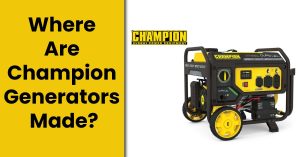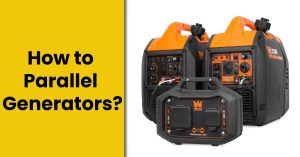How To Run A Generator In The Rain? – What To Do If Generator Gets Wet
In this article, we have explained how to run a generator in the rain in detail which includes electrocution, fire, malfunctioning safety, and some pro tips to keep the generator running in the rain.
If you are among those people who feel there is no option left but to use a generator in rainy weather.
Many workers in homestead communities or those who are living off-grid depend on a generator that requires reliability from all weather conditions.
For anyone living in a hurricane area, the generator is a very important item. One can get lifesaving power in a disaster situation with the help of a generator.
No doubt, water, and power are the two necessary things that everyone needs. These essentials can work side-by-side but when they come together then it is life-threatening. So, does it mean a generator will not run in the rain?
Can you Run A Generator In The Rain?
Running a generator in wet, rainy weather or snowfall can be extremely dangerous unless you take some precautionary measures before starting it. It is strongly advised not to run a generator in rain or wet if you do not have a high-quality generator tent or a shelter for a generator.
You will be in danger of electrocution or some kind of serious damage to your generator if you try to operate your generator in rainy weather.
However, it is possible, and here is how to run a generator in the rain:
How To Run A Generator In The Rain?
Though many manufacturers and experts do not recommend running a generator in such weather conditions due to the possible hazards. For that purpose, it is essential to make only necessary purchases, a high-quality protective cover or any kind of enclosure for running a generator.
Sometimes it won’t be possible to get away from the rain. The power blackout could be due to rain. If you are camping in this severe weather then you’ll need some power to tackle the situation.
There are only a few things you can do to protect yourself while using generators during adverse weather.
Protect Your Generator:

The initial step towards running a generator during rain is to protect it in any possible way. For doing so, there will be a need for a quality protective enclosure or a cover.
The chosen protective enclosure or cover must meet all the essential safety standards. That enclosure you prefer to select will come with mandatory instructions on setting it up in conjunction with your generator.
Consult The Manual Guide:
It doesn’t matter whatever the weather condition is outside, you should always consult the manual guide provided by the owner before running a generator.
There will be a pre-start checklist by the manufacturer of the generator and you should go through it before running your generator.
Move Your Generator Outside:
As we have already mentioned that you won’t be able to use an indoor generator due to the high risk of carbon monoxide poisoning. Also, it is critical to place a generator outside.
But you should place it at least 10-20 feet far from your living area while keeping the peace of neighbors in mind.
If you plan to place your generator outside, then you should always avoid low garden areas where pooling water is a bit risky.
To run it safely during rain, it only requires to be protected but you should always place it on a dry and flat piece of land.
If you are a resident of a region where rainfall is casual, there will be the need for considering a permanent enclosure for the generator or the whole house will need upgrading.
Comparably, by pouring a concrete pad on the property you will build a dry and flat surface to protect your generator to withstand heavy rainfall.
Connect The Generator To Appliances:
While using a generator you will need a power cord for connecting appliances. And when it’s raining, the one safe extension cord to be used will be a grounded three-prong cord.
This will keep you safe from electrical shocks or any other hazard but it will also prevent your appliances from any potential damage.
Start-Up Your Generator:
After the completion of the above steps and taking the appropriate measures to protect the generator from rain, now you can start running your generator.
You will now be able to use all of your essential appliances while waiting for the rain to stop and for grid power to come back on.
Checkout our guide about how to start a generator
The Dangers Of Running Generator In The Rain
It becomes challenging to run a generator safely in wet weather if the enclosures are not well-ventilated. Some of the major concerns related to running a generator in severe weather conditions include:
Electrocution:
This situation can take place after as well as during the storm and if you touch a wet generator when it is already running, then it can be life-threatening.
You can prevent this risk of electrocution by making sure that the generator is properly grounded.
The perfect way to do so is by installing a portable ground fault circuit interrupter.
Not only the generator will deliver a nasty shock but if you are standing in a puddle while running the generator, even the GFCI will make a little effort to soften the blow.
For your safety and the protection of your generator, it is recommended to operate it while standing on dry ground and also make sure that you have stored the generator under some kind of canopy.
Fire Hazards:
Even if you have smartly covered your generator, you can still be in danger. If there is no proper ventilation, a generator won’t get enough airflow to perform its functions effectively and there is a high chance of catching fire.
In the same way, storing fuel closer to the generator or overfilling will also result in potential fire hazards.
By keeping a car fire extinguisher at a nearby place, you can reduce the damage up to some extent but the risk won’t be eliminated.
However, a generator can be left in the rain if it is not being used. By exposing it to the elements there will need for more maintenance and more possible problems in the long run that is why it is highly recommended to build or buy a cover for your generator.
Generator Malfunction:
If somehow water gets to enter into any part of the generator, it will ruin different components and lead to irreplaceable damage to the whole unit. It will cause you great cost loss for replacement as well as the health hazards will be beyond the mark.
Checkout our guide about safety tips of generator
How To Protect Generator From Rain?
There are several ways by which you can protect your generator from rain. Below we have mentioned some of the most effective and practical ways to do so:
Get A Weather Cover:

A canopy-like cover on the generator is a very good option to go if you are using a small outdoor generator, specifically during camping. It is an ideal option for those having narrow spaces to store the shade for the generator.
These generator covers are a type of canopy or tent that you can attach easily to any portable generator.
Depending on the size of your generator, from almost 200 watts to 10,000 watts, a tent can cover it completely from rainfall.
Get A Storage Shed:
If a generator is placed beside your home, and there is no separate house for it then get a storage shed for it.
Measure the size of the generator and get the exact shade size according to your needs. These shades are well-ventilated and fully protected from any disaster such as rainfall, hurricane, or even a mild storm.
There is one drawback of enclosures that they cannot be moved around in the back of a car.
Additionally, it is not recommended to use a generator inside some solid isolations like these without proper ventilation and sound insulation.
Make An Enclosure:
You can also make an enclosure by yourself with the help of some wooden planks and an exhaust system.
To make one, try to measure the needed space, then build a little home for your generator with well-ventilated space inside.
Add good insulation at the base with the help of soft rubber feet or foam to have a few vibrations as well.
Also, add an attic exhaust fan as well as a ventilator to keep the outside air hot. Then, anchor the whole structure inside the ground with the help of bolts so it does not tear into parts by storm.
Build A Shade:
This option can be a lifesaver for DIY enthusiasts, as there will be many ways to experiment with it. Make a small size shade for the generator by applying all important processes.
You will need to make a permanent shade with a full home-like design that can also be used as storage.
It can also be made soundproof to keep the quiet peace maintained at your home and neighborhood.
Take the muffler rod outside and then point it to a downside to isolate sound while keeping the water out.
Importance Of Protecting The Generator
A generator delivers electricity by gasoline, propane, or batteries. Most units give the output through 220V or 110V outlets.
Outlets present in the home should never get wet as it will cause sparking, fires as well as electrocution. It is easy for a generator to get wet from blown-in air, heavy dew, and floodwater.
By operating a generator in wet circumstances is completely inadvisable and it should be avoided at best.
In adverse weather, try to use a generator only when the storm has passed or the condition has become clear. But there is a possible chance of operating a generator in the rain.
To safely run the generator in the rain, it needs to be fully covered or enclosed.
However, the generator requires passable air circulation to avoid overheating and the accumulation of carbon monoxide emissions. As a result, not all covers or enclosures will suffice.
Furthermore, the generator should be placed on a level, dry area. Most generator manufacturers recommend that the surface change under the generator be less than 15 degrees in all directions. Often, a flat piece of plywood will suffice to lift the generator off the moist ground.

Josh is a highly skilled electrician with specialized expertise in the field of generators. With years of experience under his belt, he has established himself as an expert in all aspects of generators, ranging from installation and maintenance to troubleshooting and repairs. Josh’s in-depth knowledge of electrical systems and his commitment to staying updated with the latest industry advancements make him a reliable and sought-after professional.






